spare tire INFINITI Q50 HYBRID 2018 Warranty Information Booklet
[x] Cancel search | Manufacturer: INFINITI, Model Year: 2018, Model line: Q50 HYBRID, Model: INFINITI Q50 HYBRID 2018Pages: 60, PDF Size: 0.27 MB
Page 29 of 60

25BRIDGESTONE FIRESTONE TIRE LIMITED WARRANTY
ORIGINAL EQUIPMENT
PASSENGER AND LIGHT TRUCK
TIRES INCLUDING RFT TIRES
WITH RUN-FLAT TECHNOLOGY
ELIGIBILITY
This Limited Warranty covers BRIDGESTONE
and FIRESTONE brand passenger and light
truck tires, including RFT and temporary
spare tires, originally installed by the vehicle
manufacturer on a new vehicle. You are
covered under the terms of this Limited
Warranty if the tire was produced after July
4, 2004 (DOT serial 2704 or later) and has
been used only on the vehicle on which it was
originally installed in non-commercial service.
WHAT IS WARRANTED AND FOR
HOW LONG
Before wearing down to 2/32 inch (1.6 mm)
remaining original tread depth (i.e. worn down
to the top of the built-in indicators in the tread
grooves) and within 6 years from the date of
purchase (proof of purchase date required;
without proof of purchase date, then within 6
years from the date of tire manufacture), for
any reason other than those excluded in the
section entitled “What This Limited Warranty
Does Not Cover,” any eligible tire that
becomes unusable for any reason within the
manufacturer’s control will be replaced with
an equivalent new tire on the basis set forth in
this Limited Warranty.
WHAT THE WARRANTY DOES
NOT COVER
This Limited Warranty does not cover the
following:
1. Tire damage or irregular wear due to:
A. Road hazards, including, without
limitation: Puncture, cut, impact break,
stone drill, bruise, bulge, snag, etc.
B. Improper use or operation, including,
without limitation: Improper inflation
pressure, overloading, tire/wheel
spinning, use of an improper wheel, tire
chain damage, misuse, misapplication,
negligence, tire alteration, or for racing
or competition purposes.
C. Insufficient or improper maintenance,
including, without limitation: Failure
to rotate tires as recommended in this
manual, wheel misalignment, worn
suspension components, improper tire
mounting or demounting, tire/wheel
assembly imbalance, or other vehicle
conditions, defects, or characteristics.
D. Contamination or degradation by
petroleum products or other chemicals,
fire or other externally generated heat, or
water or other material trapped inside the
tire during mounting or inflation. E.
Improper repair. Improper repair voids
this Limited Warranty.
F. For RFT tires only, improper run-flat or
low tire pressure operation, including,
without limitation: Exceeding speed,
distance, or other run-flat/ low pressure
operation limitations.
2. Rapid tread wear or wear-out. Original equipment tires have no mileage warranty.
3. Weather/ozone cracking after 4 years from
date of tire manufacture.
4. Ride disturbance or vibration after 1/32 inch
(0.8 mm) of tread wear use.
5. Tires with sealant, balance, or other filler
material that was not originally applied or
inserted by the tire manufacturer.
6. Tires used in commercial service.
7. Tires purchased and normally used outside
the United States and Canada.
8. The cost of applicable federal, state, and
local taxes.
9. Failure to follow any of the safety and
maintenance recommendations or warnings
contained in this manual.
This Limited Warranty is in addition to and/or
may be limited by any other applicable written
warranty you may have received concerning
special tires or situations.
(Continued on next page)
Page 32 of 60
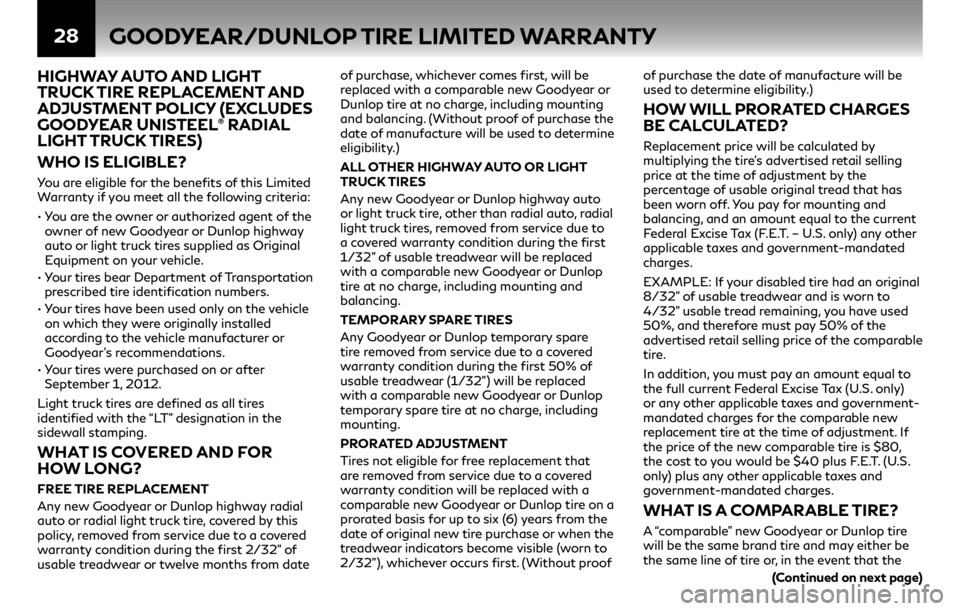
28GOODYEAR/DUNLOP TIRE LIMITED WARRANTY
HIGHWAY AUTO AND LIGHT
TRUCK TIRE REPLACEMENT AND
ADJUSTMENT POLICY (EXCLUDES
GOODYEAR UNISTEEL
® RADIAL
LIGHT TRUCK TIRES)
WHO IS ELIGIBLE?
You are eligible for the benefits of this Limited
Warranty if you meet all the following criteria:
• You are the owner or authorized agent of the
owner of new Goodyear or Dunlop highway
auto or light truck tires supplied as Original
Equipment on your vehicle.
• Your tires bear Department of Transportation prescribed tire identification numbers.
• Your tires have been used only on the vehicle on which they were originally installed
according to the vehicle manufacturer or
Goodyear’s recommendations.
• Your tires were purchased on or after September 1, 2012.
Light truck tires are defined as all tires
identified with the “LT” designation in the
sidewall stamping.
WHAT IS COVERED AND FOR
HOW LONG?
FREE TIRE REPLACEMENT
Any new Goodyear or Dunlop highway radial
auto or radial light truck tire, covered by this
policy, removed from service due to a covered
warranty condition during the first 2/32” of
usable treadwear or twelve months from date of purchase, whichever comes first, will be
replaced with a comparable new Goodyear or
Dunlop tire at no charge, including mounting
and balancing. (Without proof of purchase the
date of manufacture will be used to determine
eligibility.)
ALL OTHER HIGHWAY AUTO OR LIGHT
TRUCK TIRES
Any new Goodyear or Dunlop highway auto
or light truck tire, other than radial auto, radial
light truck tires, removed from service due to
a covered warranty condition during the first
1/32” of usable treadwear will be replaced
with a comparable new Goodyear or Dunlop
tire at no charge, including mounting and
balancing.
TEMPORARY SPARE TIRES
Any Goodyear or Dunlop temporary spare
tire removed from service due to a covered
warranty condition during the first 50% of
usable treadwear (1/32”) will be replaced
with a comparable new Goodyear or Dunlop
temporary spare tire at no charge, including
mounting.
PRORATED ADJUSTMENT
Tires not eligible for free replacement that
are removed from service due to a covered
warranty condition will be replaced with a
comparable new Goodyear or Dunlop tire on a
prorated basis for up to six (6) years from the
date of original new tire purchase or when the
treadwear indicators become visible (worn to
2/32”), whichever occurs first. (Without proof
of purchase the date of manufacture will be
used to determine eligibility.)
HOW WILL PRORATED CHARGES
BE CALCULATED?
Replacement price will be calculated by
multiplying the tire’s advertised retail selling
price at the time of adjustment by the
percentage of usable original tread that has
been worn off. You pay for mounting and
balancing, and an amount equal to the current
Federal Excise Tax (F.E.T. – U.S. only) any other
applicable taxes and government-mandated
charges.
EXAMPLE: If your disabled tire had an original
8/32” of usable treadwear and is worn to
4/32” usable tread remaining, you have used
50%, and therefore must pay 50% of the
advertised retail selling price of the comparable
tire.
In addition, you must pay an amount equal to
the full current Federal Excise Tax (U.S. only)
or any other applicable taxes and government-
mandated charges for the comparable new
replacement tire at the time of adjustment. If
the price of the new comparable tire is $80,
the cost to you would be $40 plus F.E.T. (U.S.
only) plus any other applicable taxes and
government-mandated charges.
WHAT IS A COMPARABLE TIRE?
A “comparable” new Goodyear or Dunlop tire
will be the same brand tire and may either be
the same line of tire or, in the event that the
(Continued on next page)
Page 33 of 60
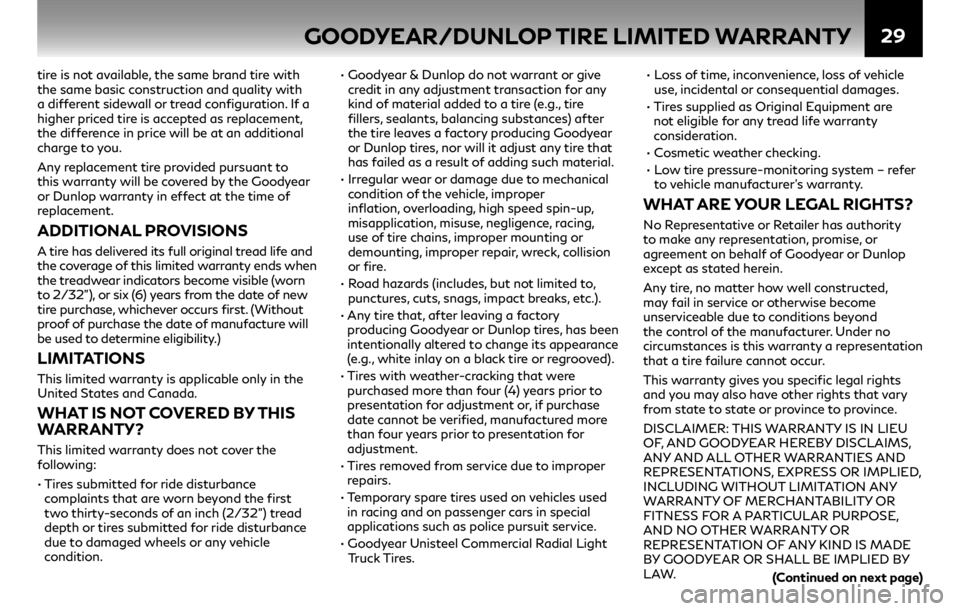
29
tire is not available, the same brand tire with
the same basic construction and quality with
a different sidewall or tread configuration. If a
higher priced tire is accepted as replacement,
the difference in price will be at an additional
charge to you.
Any replacement tire provided pursuant to
this warranty will be covered by the Goodyear
or Dunlop warranty in effect at the time of
replacement.
ADDITIONAL PROVISIONS
A tire has delivered its full original tread life and
the coverage of this limited warranty ends when
the treadwear indicators become visible (worn
to 2/32”), or six (6) years from the date of new
tire purchase, whichever occurs first. (Without
proof of purchase the date of manufacture will
be used to determine eligibility.)
LIMITATIONS
This limited warranty is applicable only in the
United States and Canada.
WHAT IS NOT COVERED BY THIS
WARRANTY?
This limited warranty does not cover the
following:
• Tires submitted for ride disturbance complaints that are worn beyond the first
two thirty-seconds of an inch (2/32”) tread
depth or tires submitted for ride disturbance
due to damaged wheels or any vehicle
condition. • Goodyear & Dunlop do not warrant or give
credit in any adjustment transaction for any
kind of material added to a tire (e.g., tire
fillers, sealants, balancing substances) after
the tire leaves a factory producing Goodyear
or Dunlop tires, nor will it adjust any tire that
has failed as a result of adding such material.
• Irregular wear or damage due to mechanical condition of the vehicle, improper
inflation, overloading, high speed spin-up,
misapplication, misuse, negligence, racing,
use of tire chains, improper mounting or
demounting, improper repair, wreck, collision
or fire.
• Road hazards (includes, but not limited to, punctures, cuts, snags, impact breaks, etc.).
• Any tire that, after leaving a factory producing Goodyear or Dunlop tires, has been
intentionally altered to change its appearance
(e.g., white inlay on a black tire or regrooved).
• Tires with weather-cracking that were purchased more than four (4) years prior to
presentation for adjustment or, if purchase
date cannot be verified, manufactured more
than four years prior to presentation for
adjustment.
• Tires removed from service due to improper repairs.
• Temporary spare tires used on vehicles used in racing and on passenger cars in special
applications such as police pursuit service.
• Goodyear Unisteel Commercial Radial Light Truck Tires. • Loss of time, inconvenience, loss of vehicle
use, incidental or consequential damages.
• Tires supplied as Original Equipment are
not eligible for any tread life warranty
consideration.
• Cosmetic weather checking.
• Low tire pressure-monitoring system – refer to vehicle manufacturer’s warranty.
WHAT ARE YOUR LEGAL RIGHTS?
No Representative or Retailer has authority
to make any representation, promise, or
agreement on behalf of Goodyear or Dunlop
except as stated herein.
Any tire, no matter how well constructed,
may fail in service or otherwise become
unserviceable due to conditions beyond
the control of the manufacturer. Under no
circumstances is this warranty a representation
that a tire failure cannot occur.
This warranty gives you specific legal rights
and you may also have other rights that vary
from state to state or province to province.
DISCLAIMER: THIS WARRANTY IS IN LIEU
OF, AND GOODYEAR HEREBY DISCLAIMS,
ANY AND ALL OTHER WARRANTIES AND
REPRESENTATIONS, EXPRESS OR IMPLIED,
INCLUDING WITHOUT LIMITATION ANY
WARRANTY OF MERCHANTABILITY OR
FITNESS FOR A PARTICULAR PURPOSE,
AND NO OTHER WARRANTY OR
REPRESENTATION OF ANY KIND IS MADE
BY GOODYEAR OR SHALL BE IMPLIED BY
LAW.
GOODYEAR/DUNLOP TIRE LIMITED WARRANTY
(Continued on next page)
Page 36 of 60

32
tires. Excessively worn tires are also more
susceptible to penetrations.
DO CHECK YOUR TIRES FOR
DAMAGE
Frequent (at least monthly) inspection of your
tires for signs of damage and their general
condition is important for safety. If you have
any questions, have your tire Retailer inspect
them. Impacts, penetrations, cracks, knots,
bulges or air loss always require tire removal
and expert inspection. Never perform a
temporary repair or use an inner tube as a
substitute for a proper repair. Only qualified
persons should repair tires.
PROPER TIRE REPAIR
NOTE: Goodyear and Dunlop do not warrant
any inspection or repair process. The repair is
entirely the responsibility of the repairer and
should be made in accordance with established
Rubber Manufacturers Association (RMA)
procedures.
TIRE PRESSURE MONITORING
SYSTEM ALERT
Refer to your vehicle Owner’s Manual for more
information on what to do if the tire pressure
warning system activates.
THE CONVENIENCE (TEMPORARY)
SPARE
The Convenience (Temporary) Spare is designed,
built, and tested to the high engineering
standards set by North America’s leading car
manufacturers and to Goodyear and Dunlop’s own high standards of quality control. It is
designed to take up a minimum of storage
space and, at the same time, fulfill the function
of a spare tire when needed. The spare is kept in
its storage space, fully inflated at 60 psi. To be
sure it is always ready for use, the air pressure
should be checked on a regular basis.
The Convenience (Temporary) Spare can be
used in combination with the original tires
on your vehicle. You can expect a tire tread
life of up to 3,000 miles (4,800 kilometers),
depending on road conditions and your driving
habits. To conserve tire tread life, return the
spare to the storage area as soon as it is
convenient to have the standard tire repaired
or replaced.
The Convenience (Temporary) Spare weighs
less than a standard tire so it’s easier to handle.
It also helps reduce the total car weight which
contributes to fuel economy.
The wheels used with the Convenience
(Temporary) Spare are specifically designed for
use with high pressure spares and should never
be used with any other type tire.
DON’T ATTEMPT TO MOUNT YOUR
OWN TIRES
Serious injury or Death may result from
explosion of tire/ rim assembly due to
improper mounting procedures. Follow tire
manufacturer’s instructions and match tire
diameter to rim diameter. Mount light truck
radials on rims approved for radial service. Do
not apply bead sealer. This can inhibit bead
seating. Lubricate beads and tire rim (including
tube or flap) contact surfaces. Lock assembly
on mounting machine or place in safety cage.
STAND BACK and never exceed 40 psi to
seat beads. Never use a volatile substance or a
rubber “donut” (also known as a bead expander
or “O-Ring”) to aid bead seating. Only
specially-trained persons should mount tires.
DON’T MIX TIRES OF DIFFERENT
SIZES AND TYPES ON THE SAME
AXLE
For optimum handling and control, Goodyear
and Dunlop recommend fitment of four (4) tires
of the same type and size unless otherwise
specified by the vehicle manufacturer.
WARNING: Before you replace your tires,
always consult the vehicle Owner’s Manual and
follow the vehicle manufacturer’s replacement
tire recommendations. Vehicle handling may
be significantly affected by a change in tire
size or type. When selecting tires that are
different than the Original Equipment size,
see a professional installer in order to make
certain that proper clearance, load carrying
capacity and inflation pressure is selected.
Never exceed the maximum load capacity and
inflation pressure listed on the sidewall of the
tire. Always drive safely and obey all traffic
laws. Avoid sudden, sharp turns or lane changes.
Failure to follow this warning may result in loss
of control of the vehicle, leading to an accident
and serious injury or death.
GOODYEAR/DUNLOP TIRE LIMITED WARRANTY
(Continued on next page)
Page 38 of 60
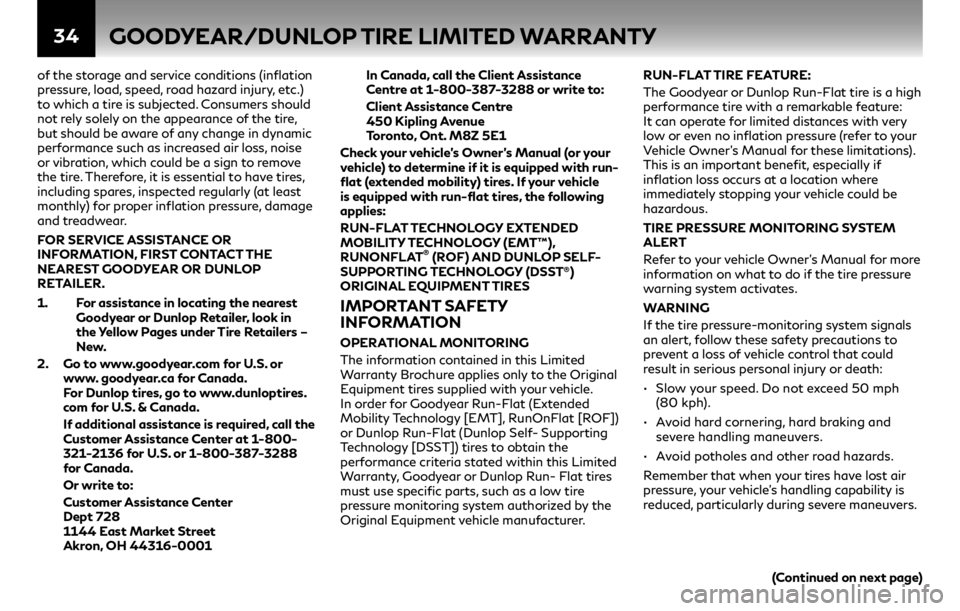
34
of the storage and service conditions (inflation
pressure, load, speed, road hazard injury, etc.)
to which a tire is subjected. Consumers should
not rely solely on the appearance of the tire,
but should be aware of any change in dynamic
performance such as increased air loss, noise
or vibration, which could be a sign to remove
the tire. Therefore, it is essential to have tires,
including spares, inspected regularly (at least
monthly) for proper inflation pressure, damage
and treadwear.
FOR SERVICE ASSISTANCE OR
INFORMATION, FIRST CONTACT THE
NEAREST GOODYEAR OR DUNLOP
RETAILER.
1. For assistance in locating the nearest Goodyear or Dunlop Retailer, look in
the Yellow Pages under Tire Retailers –
New.
2. Go to www.goodyear.com for U.S. or www. goodyear.ca for Canada.
For Dunlop tires, go to www.dunloptires.
com for U.S. & Canada.
If additional assistance is required, call the Customer Assistance Center at 1-800-
321-2136 for U.S. or 1-800-387-3288
for Canada.
Or write to:
Customer Assistance Center Dept 728
1144 East Market Street
Akron, OH 44316-0001 In Canada, call the Client Assistance
Centre at 1-800-387-3288 or write to:
Client Assistance Centre 450 Kipling Avenue
Toronto, Ont. M8Z 5E1
Check your vehicle’s Owner’s Manual (or your
vehicle) to determine if it is equipped with run-
flat (extended mobility) tires. If your vehicle
is equipped with run-flat tires, the following
applies:
RUN-FLAT TECHNOLOGY EXTENDED
MOBILITY TECHNOLOGY (EMT™),
RUNONFLAT
® (ROF) AND DUNLOP SELF-
SUPPORTING TECHNOLOGY (DSST®)
ORIGINAL EQUIPMENT TIRES
IMPORTANT SAFETY
INFORMATION
OPERATIONAL MONITORING
The information contained in this Limited
Warranty Brochure applies only to the Original
Equipment tires supplied with your vehicle.
In order for Goodyear Run-Flat (Extended
Mobility Technology [EMT], RunOnFlat [ROF])
or Dunlop Run-Flat (Dunlop Self- Supporting
Technology [DSST]) tires to obtain the
performance criteria stated within this Limited
Warranty, Goodyear or Dunlop Run- Flat tires
must use specific parts, such as a low tire
pressure monitoring system authorized by the
Original Equipment vehicle manufacturer. RUN-FLAT TIRE FEATURE:
The Goodyear or Dunlop Run-Flat tire is a high
performance tire with a remarkable feature:
It can operate for limited distances with very
low or even no inflation pressure (refer to your
Vehicle Owner’s Manual for these limitations).
This is an important benefit, especially if
inflation loss occurs at a location where
immediately stopping your vehicle could be
hazardous.
TIRE PRESSURE MONITORING SYSTEM
ALERT
Refer to your vehicle Owner’s Manual for more
information on what to do if the tire pressure
warning system activates.
WARNING
If the tire pressure-monitoring system signals
an alert, follow these safety precautions to
prevent a loss of vehicle control that could
result in serious personal injury or death:
• Slow your speed. Do not exceed 50 mph
(80 kph).
• Avoid hard cornering, hard braking and severe handling maneuvers.
• Avoid potholes and other road hazards.
Remember that when your tires have lost air
pressure, your vehicle’s handling capability is
reduced, particularly during severe maneuvers.
GOODYEAR/DUNLOP TIRE LIMITED WARRANTY
(Continued on next page)
Page 43 of 60
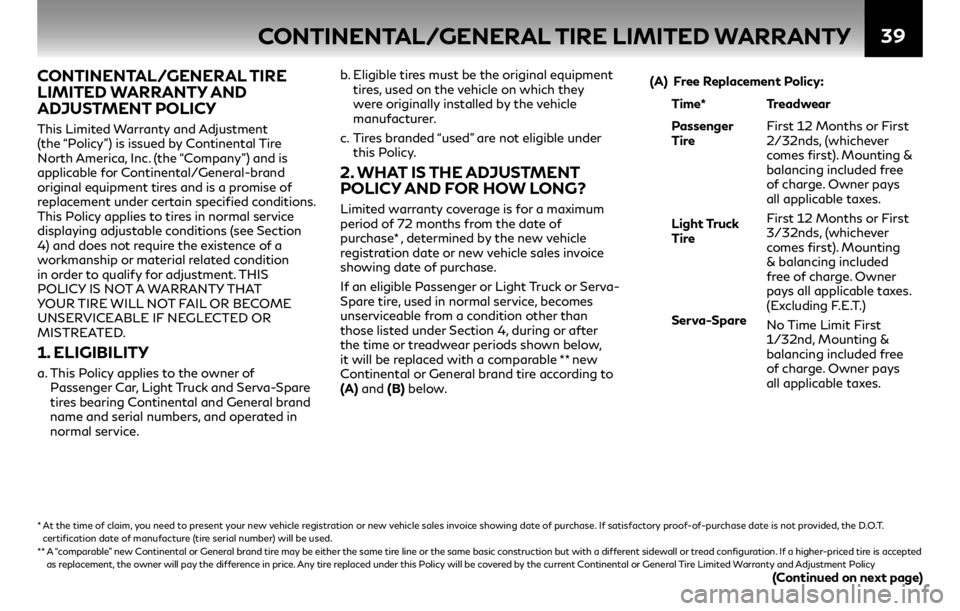
39CONTINENTAL/GENERAL TIRE LIMITED WARRANTY
CONTINENTAL/GENERAL TIRE
LIMITED WARRANTY AND
ADJUSTMENT POLICY
This Limited Warranty and Adjustment
(the “Policy”) is issued by Continental Tire
North America, Inc. (the “Company”) and is
applicable for Continental/General-brand
original equipment tires and is a promise of
replacement under certain specified conditions.
This Policy applies to tires in normal service
displaying adjustable conditions (see Section
4) and does not require the existence of a
workmanship or material related condition
in order to qualify for adjustment. THIS
POLICY IS NOT A WARRANTY THAT
YOUR TIRE WILL NOT FAIL OR BECOME
UNSERVICEABLE IF NEGLECTED OR
MISTREATED.
1. ELIGIBILITY
a. This Policy applies to the owner of Passenger Car, Light Truck and Serva-Spare
tires bearing Continental and General brand
name and serial numbers, and operated in
normal service. b.
Eligible tires must be the original equipment
tires, used on the vehicle on which they
were originally installed by the vehicle
manufacturer.
c. Tires branded “used” are not eligible under
this Policy.
2. WHAT IS THE ADJUSTMENT
POLICY AND FOR HOW LONG?
Limited warranty coverage is for a maximum
period of 72 months from the date of
purchase* , determined by the new vehicle
registration date or new vehicle sales invoice
showing date of purchase.
If an eligible Passenger or Light Truck or Serva-
Spare tire, used in normal service, becomes
unserviceable from a condition other than
those listed under Section 4, during or after
the time or treadwear periods shown below,
it will be replaced with a comparable ** new
Continental or General brand tire according to
(A) and (B) below. (A) Free Replacement Policy:
Time* Treadwear
Passenger
Tire
Light Truck
Tire
Serva-Spare First 12 Months or First
2/32nds, (whichever
comes first). Mounting &
balancing included free
of charge. Owner pays
all applicable taxes.
First 12 Months or First
3/32nds, (whichever
comes first). Mounting
& balancing included
free of charge. Owner
pays all applicable taxes.
(Excluding F.E.T.)
No Time Limit First
1/32nd, Mounting &
balancing included free
of charge. Owner pays
all applicable taxes.
* At the time of claim, you need to present your new vehicle registration or new vehicle sales invoice showing date of purchase.
If satisfactory proof-of-purchase date is not provided, the D.O.T.
certification date of manufacture (tire serial number) will be used.
** A “comparable” new Continental or General brand tire may be either the same tire line or the same basic construction but with a different sidewall or tread configuration. If a higher-priced tire is accepted
as replacement, the owner will pay the difference in price. Any tire replaced under this Policy will be covered by the current Continental or General Tire Limited Warranty and Adjustment Policy
(Continued on next page)
Page 44 of 60

40CONTINENTAL/GENERAL TIRE LIMITED WARRANTY
(B) Pro Rata Replacement Policy:
Passenger/Light Truck Tires
After the "Free Replacement Policy"
expires (set forth in section 2A), and
the tire is still within 72 months from
the date of purchase*, you will pay, on
a pro rata basis, for a comparable**
new Continental or General brand
replacement tire. A tire is eligible for an
adjustment on a pro rata basis until the
tread is worn down to the tread wear
indicators (2/32nds of an inch of tread
remaining). The tire tread is worn out at
this point and this Policy ends regardless
of time period. Owner pays all applicable
taxes (including F.E.T.), mounting and
balancing charges.
Serva-Spare Tires
After the “Free Replacement Policy”
expires (set forth in section 2A), no
adjustment will be made.
3. HOW A PRO RATA PRICE IS
CALCULATED
The replacement tire price will be determined
by multiplying the percentage of the usable
tread worn by the Retailers Selling Price
(excluding all applicable taxes) at the time of
the adjustment or the Continental/General
brand current published Adjustment Base Price, whichever is lower. The usable tread
is the original tread down to the tread wear
indicators (2/32nds of an inch of tread
remaining). The Adjustment Base Price is
intended to fairly represent a Retailer ’s Selling
Price for the same or comparable tire.
4. WHAT IS NOT COVERED BY THE
ADJUSTMENT POLICY
a.
The following conditions are not covered:
Road Hazard: Cuts, snags, punctures, bruises
or impact breaks and any damage caused
by puncture or tire repair. Ride/Vibration:
After “Free Replacement Policy” (set forth in
section 2A) expires.
Tire Damage or Failure Resulting From
Improper Operation or Maintenance: Load,
speed, and inflation practices causing
excessive operational temperatures to
exceed the tire capabilities.
Tire damage (including irregular treadwear)
or failure resulting from: improper mounting
or demounting, damaged rim, wheel
alignment, tire trueing, chain damage, brakes
or any similar mechanical problem, extreme
temperature exposure, misuse, negligence,
and abusive driving such as tire spinning,
racing or accident damage. Tire failure
resulting from intentional alterations: such
as adding a white inlay on a blackwall or
sealant materials. Age Conditions: Weather checking/cracking
coverage is for a maximum period of 48
months from the date of purchase.
b. General Exclusions -
Tire(s) submitted for an adjustment in service
for longer than 72 months from date of
purchase*, are not covered by this policy.
Tire(s) on any vehicle registered and normally
operated outside the United States and
Canada are not covered under this Policy.
For tires on vehicles normally operated
outside the United States and Canada, see
the nearest Continental or General Tire
retailer or distributor for local coverage.
Tire(s) transferred from the vehicle on which
they were originally installed are not covered
under this Policy.
Company does not offer tread wearout
coverage up to a predetermined mileage
under this Policy. Tire(s) used in racing
related activities or competitive events are
not covered by this Policy.
THIS LIMITED WARRANTY IS IN LIEU OF
ALL OTHER WARRANTIES, EXPRESS OR
IMPLIED, INCLUDING, BUT NOT LIMITED
TO, WARRANTIES OF MERCHANTABILITY
OR FITNESS FOR A PARTICULAR PURPOSE.
NO OTHER WARRANTIES, EXPRESS OR
IMPLIED, INCLUDING, BUT NOT LIMITED
TO, WARRANTIES OF MERCHANTABILITY
(Continued on next page)
* At the time of claim, you need to present your new vehicle registration or new vehicle sales invoice showing date of purchase. If satisfactory proof-of-purchase date is not provided, the D.O.T.
certification date of manufacture (tire serial number) will be used.
** A “comparable” new Continental or General brand tire may be either the same tire line or the same basic construction but with a different sidewall or tread configuration. If a higher-priced tire is accepted
as replacement, the owner will pay the difference in price. Any tire replaced under this Policy will be covered by the current Continental or General Tire Limited Warranty and Adjustment Policy
Page 46 of 60
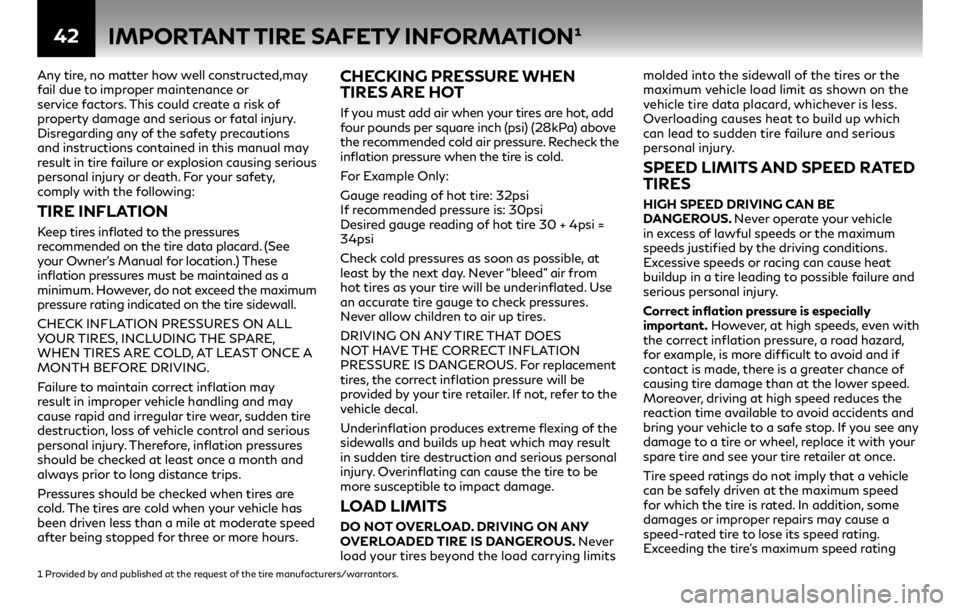
42IMPORTANT TIRE SAFETY INFORMATION¹
Any tire, no matter how well constructed,may
fail due to improper maintenance or
service factors. This could create a risk of
property damage and serious or fatal injury.
Disregarding any of the safety precautions
and instructions contained in this manual may
result in tire failure or explosion causing serious
personal injury or death. For your safety,
comply with the following:
TIRE INFLATION
Keep tires inflated to the pressures
recommended on the tire data placard. (See
your Owner’s Manual for location.) These
inflation pressures must be maintained as a
minimum. However, do not exceed the maximum
pressure rating indicated on the tire sidewall.
CHECK INFLATION PRESSURES ON ALL
YOUR TIRES, INCLUDING THE SPARE,
WHEN TIRES ARE COLD, AT LEAST ONCE A
MONTH BEFORE DRIVING.
Failure to maintain correct inflation may
result in improper vehicle handling and may
cause rapid and irregular tire wear, sudden tire
destruction, loss of vehicle control and serious
personal injury. Therefore, inflation pressures
should be checked at least once a month and
always prior to long distance trips.
Pressures should be checked when tires are
cold. The tires are cold when your vehicle has
been driven less than a mile at moderate speed
after being stopped for three or more hours.
CHECKING PRESSURE WHEN
TIRES ARE HOT
If you must add air when your tires are hot, add
four pounds per square inch (psi) (28kPa) above
the recommended cold air pressure. Recheck the
inflation pressure when the tire is cold.
For Example Only:
Gauge reading of hot tire: 32psi
If recommended pressure is: 30psi
Desired gauge reading of hot tire 30 + 4psi =
34psi
Check cold pressures as soon as possible, at
least by the next day. Never “bleed” air from
hot tires as your tire will be underinflated. Use
an accurate tire gauge to check pressures.
Never allow children to air up tires.
DRIVING ON ANY TIRE THAT DOES
NOT HAVE THE CORRECT INFLATION
PRESSURE IS DANGEROUS. For replacement
tires, the correct inflation pressure will be
provided by your tire retailer. If not, refer to the
vehicle decal.
Underinflation produces extreme flexing of the
sidewalls and builds up heat which may result
in sudden tire destruction and serious personal
injury. Overinflating can cause the tire to be
more susceptible to impact damage.
LOAD LIMITS
DO NOT OVERLOAD. DRIVING ON ANY
OVERLOADED TIRE IS DANGEROUS. Never
load your tires beyond the load carrying limits molded into the sidewall of the tires or the
maximum vehicle load limit as shown on the
vehicle tire data placard, whichever is less.
Overloading causes heat to build up which
can lead to sudden tire failure and serious
personal injury.
SPEED LIMITS AND SPEED RATED
TIRES
HIGH SPEED DRIVING CAN BE
DANGEROUS. Never operate your vehicle
in excess of lawful speeds or the maximum
speeds justified by the driving conditions.
Excessive speeds or racing can cause heat
buildup in a tire leading to possible failure and
serious personal injury.
Correct inflation pressure is especially
important.
However, at high speeds, even with
the correct inflation pressure, a road hazard,
for example, is more difficult to avoid and if
contact is made, there is a greater chance of
causing tire damage than at the lower speed.
Moreover, driving at high speed reduces the
reaction time available to avoid accidents and
bring your vehicle to a safe stop. If you see any
damage to a tire or wheel, replace it with your
spare tire and see your tire retailer at once.
Tire speed ratings do not imply that a vehicle
can be safely driven at the maximum speed
for which the tire is rated. In addition, some
damages or improper repairs may cause a
speed-rated tire to lose its speed rating.
Exceeding the tire’s maximum speed rating
1 Provided by and published at the request of the tire manufacturers/warrantors.
Page 47 of 60
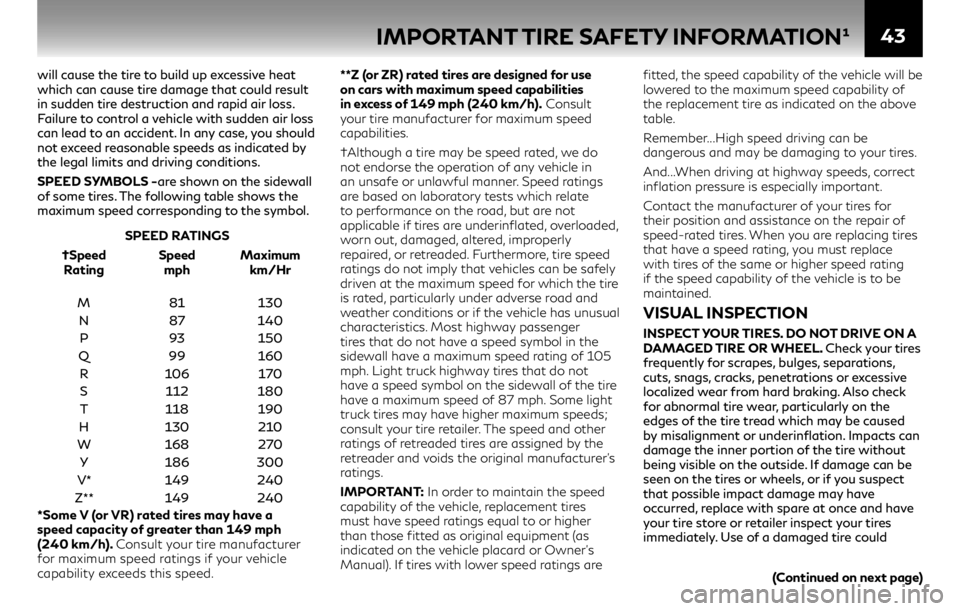
43
will cause the tire to build up excessive heat
which can cause tire damage that could result
in sudden tire destruction and rapid air loss.
Failure to control a vehicle with sudden air loss
can lead to an accident. In any case, you should
not exceed reasonable speeds as indicated by
the legal limits and driving conditions.
SPEED SYMBOLS -are shown on the sidewall
of some tires. The following table shows the
maximum speed corresponding to the symbol.SPEED RATINGS
†Speed Rating Speed
mph Maximum
km/Hr
M 81130
N8 7140
P 93150
Q9 9160
R 106 170
S 112 180
T 118 190
H 130 210
W 168 270
Y 186 300
V* 149 240
Z** 149 240
*Some V (or VR) rated tires may have a
speed capacity of greater than 149 mph
(240 km/h). Consult your tire manufacturer
for maximum speed ratings if your vehicle
capability exceeds this speed. **Z (or ZR) rated tires are designed for use
on cars with maximum speed capabilities
in excess of 149 mph (240 km/h). Consult
your tire manufacturer for maximum speed
capabilities.
†Although a tire may be speed rated, we do
not endorse the operation of any vehicle in
an unsafe or unlawful manner. Speed ratings
are based on laboratory tests which relate
to performance on the road, but are not
applicable if tires are underinflated, overloaded,
worn out, damaged, altered, improperly
repaired, or retreaded. Furthermore, tire speed
ratings do not imply that vehicles can be safely
driven at the maximum speed for which the tire
is rated, particularly under adverse road and
weather conditions or if the vehicle has unusual
characteristics. Most highway passenger
tires that do not have a speed symbol in the
sidewall have a maximum speed rating of 105
mph. Light truck highway tires that do not
have a speed symbol on the sidewall of the tire
have a maximum speed of 87 mph. Some light
truck tires may have higher maximum speeds;
consult your tire retailer. The speed and other
ratings of retreaded tires are assigned by the
retreader and voids the original manufacturer’s
ratings.
IMPORTANT: In order to maintain the speed
capability of the vehicle, replacement tires
must have speed ratings equal to or higher
than those fitted as original equipment (as
indicated on the vehicle placard or Owner’s
Manual). If tires with lower speed ratings are
fitted, the speed capability of the vehicle will be
lowered to the maximum speed capability of
the replacement tire as indicated on the above
table.
Remember...High speed driving can be
dangerous and may be damaging to your tires.
And...When driving at highway speeds, correct
inflation pressure is especially important.
Contact the manufacturer of your tires for
their position and assistance on the repair of
speed-rated tires. When you are replacing tires
that have a speed rating, you must replace
with tires of the same or higher speed rating
if the speed capability of the vehicle is to be
maintained.
VISUAL INSPECTION
INSPECT YOUR TIRES. DO NOT DRIVE ON A
DAMAGED TIRE OR WHEEL.
Check your tires
frequently for scrapes, bulges, separations,
cuts, snags, cracks, penetrations or excessive
localized wear from hard braking. Also check
for abnormal tire wear, particularly on the
edges of the tire tread which may be caused
by misalignment or underinflation. Impacts can
damage the inner portion of the tire without
being visible on the outside. If damage can be
seen on the tires or wheels, or if you suspect
that possible impact damage may have
occurred, replace with spare at once and have
your tire store or retailer inspect your tires
immediately. Use of a damaged tire could
IMPORTANT TIRE SAFETY INFORMATION¹
(Continued on next page)
Page 48 of 60
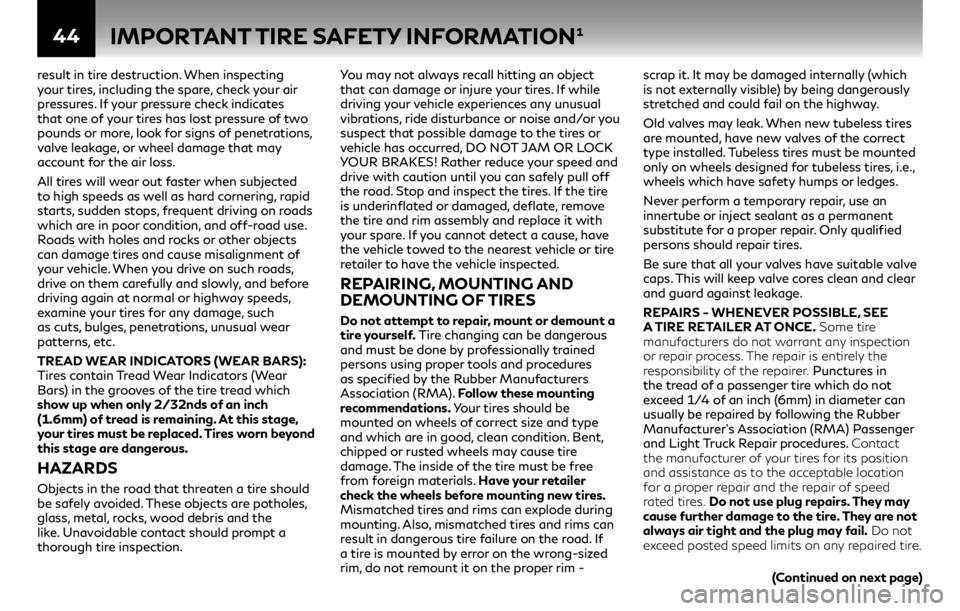
44IMPORTANT TIRE SAFETY INFORMATION¹
result in tire destruction. When inspecting
your tires, including the spare, check your air
pressures. If your pressure check indicates
that one of your tires has lost pressure of two
pounds or more, look for signs of penetrations,
valve leakage, or wheel damage that may
account for the air loss.
All tires will wear out faster when subjected
to high speeds as well as hard cornering, rapid
starts, sudden stops, frequent driving on roads
which are in poor condition, and off-road use.
Roads with holes and rocks or other objects
can damage tires and cause misalignment of
your vehicle. When you drive on such roads,
drive on them carefully and slowly, and before
driving again at normal or highway speeds,
examine your tires for any damage, such
as cuts, bulges, penetrations, unusual wear
patterns, etc.
TREAD WEAR INDICATORS (WEAR BARS):
Tires contain Tread Wear Indicators (Wear
Bars) in the grooves of the tire tread which
show up when only 2/32nds of an inch
(1.6mm) of tread is remaining. At this stage,
your tires must be replaced. Tires worn beyond
this stage are dangerous.
HAZARDS
Objects in the road that threaten a tire should
be safely avoided. These objects are potholes,
glass, metal, rocks, wood debris and the
like. Unavoidable contact should prompt a
thorough tire inspection. You may not always recall hitting an object
that can damage or injure your tires. If while
driving your vehicle experiences any unusual
vibrations, ride disturbance or noise and/or you
suspect that possible damage to the tires or
vehicle has occurred, DO NOT JAM OR LOCK
YOUR BRAKES! Rather reduce your speed and
drive with caution until you can safely pull off
the road. Stop and inspect the tires. If the tire
is underinflated or damaged, deflate, remove
the tire and rim assembly and replace it with
your spare. If you cannot detect a cause, have
the vehicle towed to the nearest vehicle or tire
retailer to have the vehicle inspected.
REPAIRING, MOUNTING AND
DEMOUNTING OF TIRES
Do not attempt to repair, mount or demount a
tire yourself. Tire changing can be dangerous
and must be done by professionally trained
persons using proper tools and procedures
as specified by the Rubber Manufacturers
Association (RMA). Follow these mounting
recommendations. Your tires should be
mounted on wheels of correct size and type
and which are in good, clean condition. Bent,
chipped or rusted wheels may cause tire
damage. The inside of the tire must be free
from foreign materials. Have your retailer
check the wheels before mounting new tires.
Mismatched tires and rims can explode during
mounting. Also, mismatched tires and rims can
result in dangerous tire failure on the road. If
a tire is mounted by error on the wrong-sized
rim, do not remount it on the proper rim - scrap it. It may be damaged internally (which
is not externally visible) by being dangerously
stretched and could fail on the highway.
Old valves may leak. When new tubeless tires
are mounted, have new valves of the correct
type installed. Tubeless tires must be mounted
only on wheels designed for tubeless tires, i.e.,
wheels which have safety humps or ledges.
Never perform a temporary repair, use an
innertube or inject sealant as a permanent
substitute for a proper repair. Only qualified
persons should repair tires.
Be sure that all your valves have suitable valve
caps. This will keep valve cores clean and clear
and guard against leakage.
REPAIRS - WHENEVER POSSIBLE, SEE
A TIRE RETAILER AT ONCE.
Some tire
manufacturers do not warrant any inspection
or repair process. The repair is entirely the
responsibility of the repairer. Punctures in
the tread of a passenger tire which do not
exceed 1/4 of an inch (6mm) in diameter can
usually be repaired by following the Rubber
Manufacturer’s Association (RMA) Passenger
and Light Truck Repair procedures. Contact
the manufacturer of your tires for its position
and assistance as to the acceptable location
for a proper repair and the repair of speed
rated tires. Do not use plug repairs. They may
cause further damage to the tire. They are not
always air tight and the plug may fail. Do not
exceed posted speed limits on any repaired tire.
(Continued on next page)